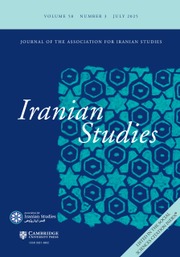No CrossRef data available.
Article contents
Récit: Narrative Movement in Sadeq Hedayat's Buf-e- Kur (The Blind Owl)
Published online by Cambridge University Press: 11 September 2025
Abstract
This paper examines Sadeq Hedayat's The Blind Owl through the lens of récit, focusing on the non-linear structure and elusive nature of the narrative. By analyzing the fluidity of time, space, and identity, the study argues that the seeming narrative flaws – including the instability of characters and shifting perspectives – are deliberate artistic strategies. Central to this reading is the concept of barzakh, the in-between state, which frames the narrator's ongoing struggle to navigate the boundaries between life and death, reality and imagination. The narrator's inability to fully express himself through art reflects this tension, as each attempt to articulate his vision reveals the inadequacy of language and the inherent impossibility of fully capturing the essence of life in art. The récit form reinforces this theme by immersing the reader in an unfinished, ever-shifting narrative, where meaning remains just beyond reach. This study highlights the importance of reading The Blind Owl as a récit to better understand its existential exploration and critique of the artist's role in grappling with the unknown.
Information
- Type
- Article
- Information
- Copyright
- © The Author(s), 2025. Published by Cambridge University Press on behalf of The Association for Iranian Studies.


